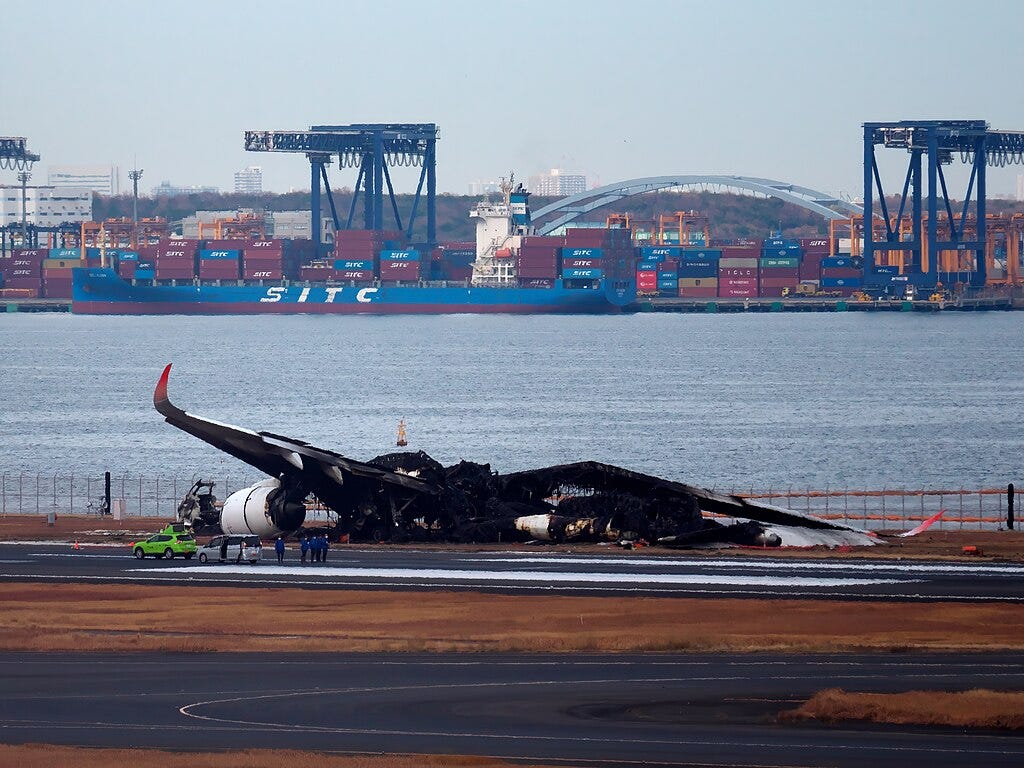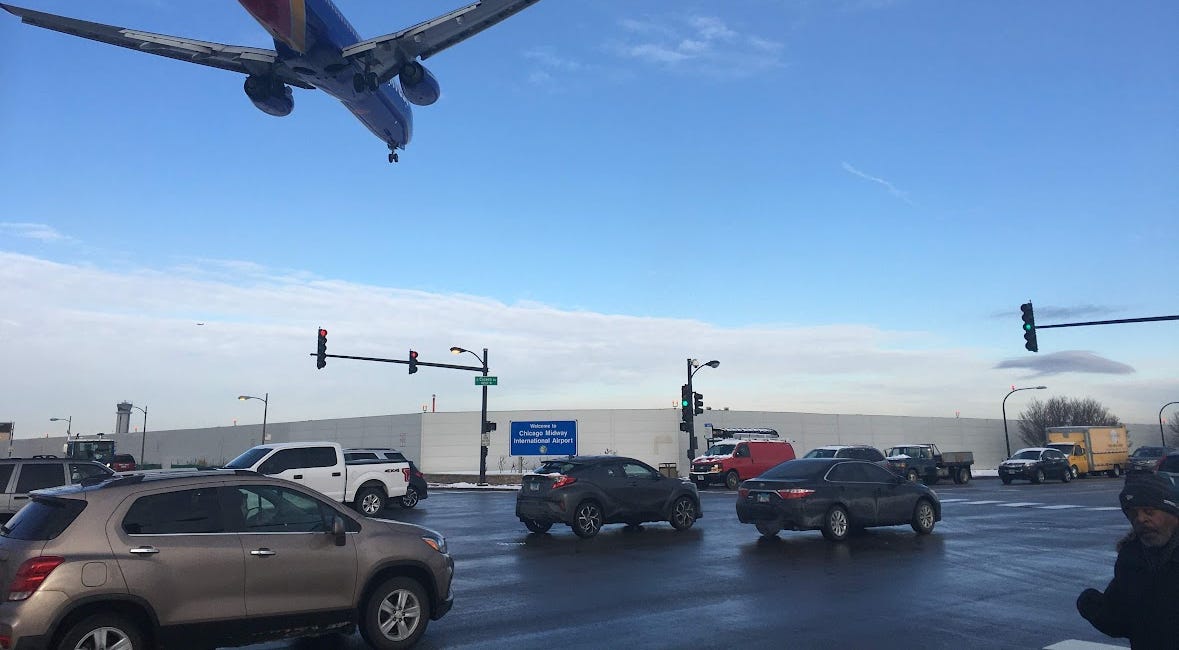Japan is having a hard year already. We are only a few days into 2024 and the island nation has already suffered a 7.5-magnitude earthquake that triggered a tsunami that occurred only hours into the new year and a major airline crash at one of its busiest airports. I’m no expert on earthquakes, but I can tell you a thing or two about the crash.
The crash occurred at Tokyo’s Haneda airport on January 2 at about 5:47 pm. Japan Air Lines Flight 516, an Airbus A350, was landing on Runway 34R (the designation denotes the right runway of a parallel pair with a direction of 340 degrees) when it collided with a DeHavilland Canada Dash-8 operated by the Japanese Coast Guard. The Airbus A350 is one of the world’s newest jetliners while the Dash-8 is a turboprop regional airliner that first flew in 1983. The flight identifier for the Coast Guard Dash-8 was JA722A.
Video from a closed-circuit camera shows the Airbus on its landing rollout when it suddenly erupts into flame. Momentum carries the burning airplane further down the runway leaving a trail of smoke and fire.
The fact that none of the 379 passengers on the Airbus were killed is nothing short of miraculous. The crew of the Dash-8 was not so lucky. Of six people on board, only the captain survived and he sustained serious injuries.
The passengers and crew on the Airbus are very fortunate to be alive. Certification requires that an airplane be evacuated within 90 seconds. The Wall Street Journal reported that it took 18 minutes to empty Flight 516. That is an eternity in an aircraft fire. ABC News even included a social media screengrab of the smoky cabin after the collision.
Let me just stop here and say that if you are in a burning aircraft, don’t stop to take pictures. Seconds count.
You also should be listening to the safety briefing before the flight because the way out is different on different airliners. At the very least, you should familiarize yourself with the nearest exits both in front of you and behind you (counting rows to the exit is a pro tip) as well as making note of the color of the lights that lead to and indicate exits. The Haneda crash shows just how quickly things can go sideways, and in a sudden emergency in a dark, smoke-filled airplane you can’t count on having time to get out the safety card to refresh your memory.
A diagram of the airport by the Aviation Safety Network posted to Facebook shows the accident site as well as where the Airbus came to rest. Tokyo is out of my operational area so I don’t have more detailed charts for the airport, but they are available online. This online data may not be current but can shed light on the accident.
Per the online chart and assuming the Wikipedia diagram is correct, the collision took place near the intersection of Runway 34R and Taxiway C5. The Airbus apparently came to rest between taxiways C10 and C11. The published distance of the runway is 11,024 feet. Judging from the chart, this means that the Airbus continued for more than a mile before coming to a stop.

What happened is a lot easier to relate than why it happened. It is generally considered a bad thing for two airplanes to occupy a runway at the same time. The technical term for when an airplane enters a runway without clearance is “runway incursion,” and the investigation will center on which airplane was not supposed to be there, why it was where it wasn’t supposed to be, and why safeguards did not alert tower controllers to the danger.
In the case of JAL 516, the error seems to have been on the part of the Dash-8 pilot. The radio phraseology used in the exchange reported by the Aviation Safety Network is not the standard phraseology used in the US, but I believe that the clearance to “taxi to the runway stop position on C5” was a clearance to taxi to the runway but stop short of it. “Number one” meant that the Dash-8 was first in line for takeoff.
In the US, the clearance would have been something like, “JAL722A, you are number one for takeoff, taxi to [and hold short of] Runway 34R at intersection C5.”
Typically, aircraft are expected to “hold short” of the runway until cleared onto it. This permission would come in the form of a takeoff clearance or a clearance to “line up and wait.” Older pilots may remember the old “taxi into position and hold” clearances, which were changed several years ago to conform with international standards.
I’ll insert here as well that the plan was probably for the Dash-8 to perform an intersection takeoff. Small planes don’t always need the full length of the runway, particularly when the runway is 11,000 feet long. This is not an abnormal procedure.
Some might question that the transcript does not show a landing clearance for the Airbus, but the version in the graphic has been edited. The complete transcript available on the ASN website does show the Airbus receiving and acknowledging a clearance to land.
CNN reporting confirms this interpretation of events, so it seems likely that the Dash-8 crew wandered onto the runway without a clearance. There are two probable reasons that explain this deviation. First, Haneda is a big airport and it was dark. It can be easy to become disoriented and lost, especially if a pilot is not familiar with the airport. They might have simply taken a wrong turn and missed the hold-short line.
The second explanation is that the pilot of the Dash-8 might have mistakenly thought that they were cleared for takeoff. Typically in a two-person flight crew, one pilot operates the controls and another communicates on the radio. The pilot who was taxiing the airplane might have misunderstood the clearance.
The pilot working the radios should be monitoring the pilot at the controls, particularly at a busy and complex airport like Haneda. If the non-flying pilot saw the pilot taxiing onto a runway without clearance, he should have confronted him. There have been accidents, both in Asia and elsewhere, where a lower-ranking, inexperienced pilot did not want to question a superior, however.
Other factors can be at play as well. Fatigue is a longtime problem in aviation that may have played a role. We don’t know about the duty day of the Dash-8 crew, but they were apparently ferrying relief supplies to the earthquake zone. It’s very possible that they were flying tired, and flying tired can lead to mistakes.
There are reports in Japanese media that the Dash-8 captain said that he had “obtained permission to take off,” but the ATC transcripts do not support that claim.
All of this leaves more questions. One such loose end is why the Airbus crew and the controllers in the tower notice the other airplane on the runway.
The darkness was almost certainly a factor. Standard procedure for many flight departments and airlines is to turn on all the lights when entering the runway. I don’t know if the Japanese Coast Guard follows this procedure, but if the crew blundered onto the runway unaware they might not have had all of their lights on.
Either way, there are lots of lights around airports, and to the airliner approaching from the Dash-8’s rear, many of the brightest lights would not have been visible. Depending on the exact lighting options installed, the Airbus crew might only have been able to see the Dash-8’s single, white navigation (position) light on the rear of the plane. This light could have easily blended in with all the other runway lights.
The tower controllers might have had a better view, but they were also dividing their attention between numerous aircraft, radios, and administrative tasks. Some airports have surface movement radar to help controllers track taxiing aircraft, especially in periods of low visibility, but I have not been able to confirm that this system was installed and functional at Haneda.
There are indications that another safety system was not operative on January 2. ABC News reported that “warning lights that tell pilots whether a runway is clear” were not working at the time of the crash. This is an apparent reference to stop-bar lights that create an illuminated red barrier across the taxiway when a runway is in use. These lights might have alerted the Dash-8 pilot to the fact that he was entering an active runway without permission if they had been operational.
Most aviation accidents are attributable to more than one cause. Often they are chains of individual actions and events that, when linked together, lead to the accident. Breaking the chain can prevent accidents and save lives. My observations here don’t reflect an official analysis of the crash, but they do point to several possible links in the accident chain.
Even though the accident occurred in Japan, the US has had its share of near misses in similar incidents. Last August, I reported on a New York Times study of near misses in the aftermath of several highly publicized runway incursions. These included several close calls with American airliners that could have easily ended up looking like Japan Air Lines 516.
Despite the fire and deaths in Japan, commercial aviation is still extremely safe. That doesn’t mean that it is risk-free, however. As I said earlier, pay attention to the flight attendants when they give the safety briefing. It may save your life some dark night.
MR. TRUMP GOES TO THE SUPREME COURT (AGAIN): Donald Trump has officially appealed the Colorado Supreme Court ruling rending him ineligible to appear on Colorado ballots to the US Supreme Court. As you may recall, the Colorado court stayed its decision until January 4 (omigosh that’s today!) so the US Supreme Court has to decide quickly if it will take the case.
IRANIAN TERROR ATTACK: Another story I’m watching is the ironic tale of a bombing at a memorial service for Qasem Soleimani at his burial site on the fourth anniversary of his death. CNN reports that at least 103 people were killed and 188 injured by two bombs in Kerman, Iran. It isn’t clear who carried out the attack.
EPSTEIN DOCUMENTS RELEASED: Hundreds of pages of legal documents from a lawsuit involving Jeffrey Epstein have been released. The documents mention both Bill Clinton and Donald Trump but so far do not link either to criminal activity.
My previous runway incursion story:


No comments:
Post a Comment